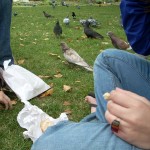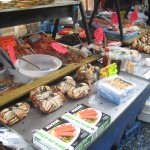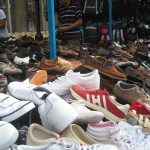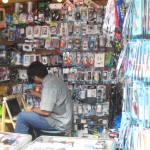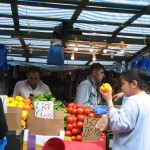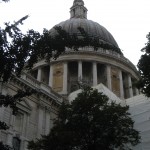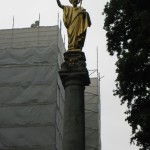Entries Tagged as 'Andrew F'
Interspersing our travels from pub to pub for our walking tour, we decided to take a much needed Americana break. And what better place to go for a greasy, cheap Yankee fix than good old Mickey D’s. Before we even entered the restaurant, the not-so-subtle differences between McDonald’s in America versus Europe were apparent. One of the most distinguishing characteristics of an American McDonald’s is the ever prevalent red and yellow coloring, clinically proven to be associated with hunger and increased stimulation of the senses. Billions and billions served, right?
Another key aspect of any McDonald’s is their uncomfortable seating and their open dining areas. The seating in American McDonald’s are intentionally uncomfortable because they want you sit, eat, and get out as soon as possible in order to accommodate the next wave of kids with the munchies. The open areas perpetuate this with feelings of nakedness and over-exposure. In stark contrast, the McDonald’s here in London has a greenish brown color and a much different architectural design. Instead of one big open space, it was split into two relatively cramped floors furnished with cushy chairs on the lower level and long tables, comfortable stools, and a relaxed, cafe style sitting corner on the upper floor. This is most likely done in an attempt to fit in with the chic surroundings of the European cheap eating market. The menu above the counter featured “The M,” which is essentially a glorified quarter pounder with cheese, except much pricier and on a ciabatta roll. But it was advertised in such a pretty font! They also had free wi-fi, which is sweet.

From http://snackspot.org.uk. So succulent. So overpriced.
From http://snackspot.org.uk. So succulent. So overpriced.
This brings up an important difference between American and European eating habits. Fast food back in the States is called fast for a reason. Customers generally don’t spend hours on end sitting in a Burger King. Drive-thrus come standard with every establishment. I have seen literally one drive-thru since I’ve been here. It seems that the European equivalent of the American fast food burger joint is the cafe. Pret a Manger and Eat cafes, not McDonald’s and Wendy’s (although there are a surprisingly large quantity of KFCs) dominate the cityscape. Cafes go hand-in-hand with the laid back attitude so prevalent in this continent.
This is a photograph of a London McDonalds. The one following is American.

http://coolboom.net/en/wp-content/uploads/2007/09/mcdonalds-london2.jpg

http://www.norh.com/news/0904/news-0904/insidemcdonalds.jpg
There is no way an American style McDonald’s could survive in London. The McDonald’s at St. Paul’s was sandwiched between two cafes. The decor and atmosphere of the restaurant effectively fit in with its distinctively European neighbors. The stereotypical American McD’s – bright, noisy, grungy, and crowded – would wither and die in the face of the far superior and definitely healthier European chain cafes. And although the fatty, disgusting-but-oh-so-good food is exactly the same, the atmosphere makes us feel healthier, and thus happier. Perhaps if the fast food places of the United States were more like the ones here they would not have such a negative reputation. Or maybe more cafes like Pret ought to pop up on our streets back home. Who knows?
Tags: Andrew B · Andrew F · Andrew R · Campbell
When I was first told about the Notting Hill Carnival, I have to say I was quite excited about getting the opportunity to attend. However, I really had no idea what to expect. I was told it was the second biggest street festival in Europe, so naturally I thought it would be intense. When we arrived in the morning it seemed pretty dead. The rubbish in the streets told me the prior day must have been quite a good time. I am glad that one of my first discoveries was a 2 litre bottle of Strongbow cider; something I did not expect to see at all. Nonetheless, my initial reaction was one of disappointment. We just walked about looking for a place to sit in order to watch the inevitable parades.
Despite the disappointing morning, the carnival came to life as noon approached. The first thing we saw was a very diverse parade. The participants ranged from a person dressed in what appeared to be a wedding dress with attached skeletons and machine guns to dinosaurs, a snake/bird creature and Corona girls. It appeared like everyone was having a good time, but I was still expecting more people. Luckily, the crowds did begin to grow once we started walking around the neighborhood.
One aspect of the carnival which really interested me was the political graffiti. It seemed that almost all of it, from what I saw, was “leftist” in nature. Two in particular caught my eye. One was a banner of sorts with Che Guevara in the middle. Spray painted on the red background was “Who the f*ck is this” with the response “Surely not Che?” I thought this was very interesting and entertaining. The other piece of graffiti I enjoyed was just a quote spray painted on wood which said “In a democracy dissent is an act of faith.” Overall, I am glad I was able to spot the graffiti I did see and be able to capture it through a lens before it was washed away.
-
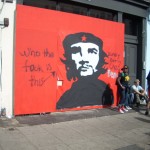
-
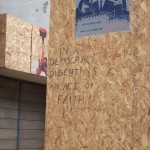
In the end, I really liked what I saw of the carnival. The food was simply amazing and very numerous. It was hard not to walk five feet and not spell something delicious being cooked. The parades were also fun to watch, especially the Jamaican one. Nevertheless, I still did expect more people. Though the crowds were pretty big, for the second largest street festival in Europe, I was disappointed at the amount of people. Of course, that does not mean I would not come back because it was an amazing experience and one I do not regret.
Tags: Andrew F
I heard only good opinions about the British Museum so I was excited when I finally got the chance to visit it. Of course, what I heard was true as the British Museum was incredible. The exhibits were numerous and very well done. I had the opportunity to visit sections on Egypt, India and Japan. The artifact which struck me the most was the Rosetta Stone. One of the greatest discoveries ever was right in front of my face. It was hard to believe that I was actually staring at it and not at a textbook picture which we are all familiar with.
The Indian and Japanese exhibits were also amazing. Each had new information which, as a History major, I find fascinating. I also think that the diversity of the British Museum speaks to the diversity of London. So much culture is packed into such a small place in both the museum and in London. It is that ability to have so much together and have it work which made the British Museum spectacular, as is the case with London.
The Tate Modern is another story. I am not a big art person so I really didn’t know what to expect. I heard about the explicit nature of some of the work, and naturally I had to see what all the fuss was about. Overall, modern art is interesting, but I am not sure if it is for me. I did like the piece which was just a huge table and four chairs. I thought the best was a piece in which the words “The End” were covered by long grass. Nonetheless, the vast majority of the artwork did not appeal to me. As for the explicit works, I didn’t see any artistic value in them. Granted, I don’t know much about art, but I still think I didn’t find much “art” in them.
Tags: Andrew F
I always wanted to visit Stonehenge from the very moment I saw a picture of it. There was something about its mystical nature which attracted me to it, and I am sure that I’m not alone in that regard. Naturally, when I heard we would be visiting Stonehenge I was ecstatic. The bus ride there was the perfect opportunity to ready myself to face one of the greatest human creations. As we slowly moved away from the hustle and bustle of London to the countryside of England, my mood changed and I became much more relaxed. The green landscape was a relief to see after so much time in the concrete jungle.
When we finally got to Stonehenge I was beyond happy. Trying to grasp the fact that this monument was created thousands of years ago without any modern technology to move the massive stones is quite challenging. Slowly walking around the structure, I had to marvel at the amazing nature of human engineering. Unfortunately, our visit was not that long; I wish I could visit Stonehenge more often since it is the perfect place for contemplation. Though we saw it during the morning, I would have loved to see it at night. I think such a structure can be better appreciated under a veil of darkness. To be surrounded by those stones under a starry night sky, deep in thought, would be a dream come true.
Bath was also great, but I found it to be too touristy. There is amazing history inside the town but I felt like all the people and services which catered to them took away from what Bath really has to offer. However, I did enjoy the Roman baths very much. I found the untreated water to be fascinating to look at. The audio guides were also very helpful and informative, as were the displays inside. Also, Bath has great parks; I must have spent almost two hours relaxing and thinking.
At the end of the day, I realized how much I had thought that day and how peaceful it was. I was grateful I had the opportunity to visit both Stonehenge and Bath. It was a necessary break from London and one I hope to have opportunity to do again.
Tags: Andrew F
I have to admit that I have not been to many plays in my life. As a matter of fact, the last play I remember attending was in middle school. If I recall correctly it was “Romeo and Juliet,” but I do not remember the performance at all. Fortunately, tonight we were able to see “Troilus and Cressida” in the Globe Theatre. At first, I was a bit apprehensive about standing for three hours and I am sure I wasn’t alone in that regard. Though that is what a “groundling” had to do and trying to recreate it makes The Globe historically accurate, I would have greatly appreciated a chair. Nevertheless, despite the lack of chairs and occasional rain, I thought the play was fantastic.
Every actor did a phenomenal job, the music was incredible and the props were well created. There were too many humorous scenes to mention, but overall the way in which the play was done was amazing. In particular, I thought the fight scenes were very well done. I also enjoyed the drums at the end, which was very unexpected. Perhaps because of all this, I did not realize at the end that three hours had passed. The entire performance was so mesmerizing that it just took me in.
Since I am so used to seeing entertainment through a screen, live acting was a treat. It seemed so much more authentic; the actors were right in front of you and they commanded your attention. I am excited to see more plays while in London and take this new passion back to the States.
Tags: Andrew F
After the highly informative Westminster Abbey tour, we decided to economize and out outside rather than pay extra to sit in. Unfortunately, we decided on the wrong park. Completely unbeknownst to us unwitting Americans, the British government is not content with simply extorting us at restuarants. Instead, they have decided to charge individuals for the “right” to sit in lawn chairs in the parks surrounding London. Though to be fair, we do not know if this is entirely true because this incident just occured at the wonderful St. James’ Park. While asthetically pleasing, the man walking around with a pence machine was very disconcerting. Being the crass Americans we are, instead of paying this man representing the greedy British government, we resevered our right to sit freely on the grass (despite his several attempts to swindle us). After suggesting that this incident reminded us of the rediciously “tea tax” placed on British imports to America in the 18th Century, we considered throwing our lawn chairs in the River Thames just to prove a point. Though after careful consideration and debate, we decided against this plan of action.
Instead, we rebelled by giving the local pigeon population the remains of our lunches. To our shock, we were unexpectedly surrounded but what seemed to be the entire pigeon population of London. Nevertheless, this did not deter us. Upon luring this savage creatures as close as possible and feeding them scrapes of bread, Amy decided to charge through the mass of beasts only to have one nearly miss Maddy and promoting the other people around us to duck for cover. With the pigeons well fed, the rebellion spread to some British children. We can only hope this incident will spark civil war among the park goers of London.
These are just a few differences between the American and British way of life.
Tags: Andrew F · Campbell
Today we went on a tour of Westminster Abbey. I had an idea of what I would be seeing but I had no idea what I would be feeling. I am not a religious person in any sense of the word; it must have been years since I last stepped into a church. Yet ever before entering Westminster Abbey I could tell there was something different about this church. It gave off the appearance of grandeur and made me feel in awe. Upon entering I knew that this church was different than any I have ever been in before. Though filled with tourists, I could imagine the Benedictine monks of the past walking silently, in deep thought and prayer. There was something about that mental image which was very appealing. Spiritual silence; complete and tranquil.
On top of all this was the sense of being surrounded by great individuals, long gone but not forgotten. The burial ground of the “Unknown Warrior” was particularly striking. The story behind it was incredible and the fact that this British soldier was awarded the Congressional Medal of Honor is all the more remarkable. Everywhere I turned I saw more and more famous individuals, whether Henry V, Mary Queen of Scots, Sir Isaac Newton, Charles Dickens or Charles Darwin.
With that in mind, I am glad that someones ideas we think challenge religious belief is actually buried in Westminster Abbey. Charles Darwin’s name has been thrown around to promote this and that and whatever else. But the fact that this man is buried in one of the greatest churches on the planet is a testament to the human ability to reconcile differences and respect one another, no matter what. Belief in God is certainly no prerequisite to feel the sense of awe and peace within Westminster Abbey.
Tags: Andrew F
Today we took a walking tour of Bloomsbury. Before beginning I had no idea what to expect; I truly did not realize the amount of history that is so close to the Arran House. The amount of famous people who lived or worked in Bloomsbury is impressive. Whether it was John Maynard Keynes, Bertrand Russell, George Orwell or Virginia Woolf, you can’t but be impressed. I found it especially eerie that the Senate House of the University of London where Orwell worked and learned the in’s and out’s of propaganda really did give the the feeling of the “Ministry of Truth.” In the end, it is amazing to think that where you just walked could have been the same place as where one of the aforementioned individuals did so as well.
Perhaps what most interested me was the evolution of the Squares and the Square Gardens. What once was an exclusive membership reserved for only those in a particular Square now is open to everyone. It is obvious the class plays an important role throughout British history, but it fascinating to see how the dynamics of class change. I was particularly struck by a statue of Gandhi. The statue seems out of place yet shows how the British deal with their feelings about their past. Even with this, the statue was transformed into a symbol of peace and non-violence when the 7/7 attacks occurred. People gathered to mourn the attacks and lay flowers around a figure who was at one time seen as an enemy of British power. The transformation from enemy to symbol of peace and non-violence is remarkable.
Tags: Andrew F
We took the Central Line from Goodge Station and switched onto the Waterloo line to Elephant and Castle at Charing Cross. As we moved farther down the line, we noticed that the number of business suits diminished and were replaced by more eccentric garb and hairstyles. After getting off at Elephant and Castle, we started to head in the right direction (towards Walworth Street) only to be re-routed (due to a “fatal accident” involving a bus) down a rather sketchy alleyway, only to make one giant loop and end up where we started. We wandered around, getting even more lost, and after consulting A-Zed, we finally got our bearings and headed down Walworth Street towards the East Street Market. Once there, we were bombarded with a rush of people, wares, sounds and smells. Reggaeton blasted from a CD and cassette tape booth, women in burkas sat under a tent draped with pashmina scarves and the aroma of bangers and burgers hung heavily in the air over the scene. Middle-Eastern and African vendors sold seafood and exotic fruits and vegetables arranged in wooden crates, and women loaded the produce into their bags, bartering with the vendors. There were booths selling watches, clothing (suits, dress shirts, slacks and lingerie), shoes, belts, toys, Christian books and movies, hats, sunglasses, jewelry, bags, scarves, cell phone accessories, linens and toiletry and cleaning products. But more interesting than the wares being sold was observing the interactions between those selling and buying. Vendors, for the most part, kept to themselves and did not call out to passersby. Some left their booths completely vacant and vulnerable to theft. One vendor in particular caught our attention. One of the few white British fruit vendors angrily accosted a potential buyer. As we were passing, we heard the vendor say to the man, “Speaking bloody f***ing English, you f***ing Bangladeshi.” The man walked away from the booth, and responded in very clear English, “English c**t.” We were shocked by witnessing obvious racial tension for the first time. It has become such a common scene in London to see people of all ethnicities sharing common spaces and interacting amicably with one another, and the altercation took us by surprise. Finally, we took the 176 to Tottenham Court Road and headed back home. While tensions do obviously exist in England, places such as East Street Market represent, for the most part, the harmony and co-existence between cultures which necessarily occurs every day in London.
Tags: Andrew F · Andrew R · Anya · Markets
We took the tube in London for the first time. After getting our new phones we caught the Central Line from Tottenham Court Station to St Paul. We wandered around the church and than found the City of London where we walked around the financial and business district before catching the bus back to Tottenham Court Road. We picked the St Paul Cathedral as our monument which was under construction and found that most people in the area were wearing suits and walking very quickly and with purpose.
The stores in the area were very expensive and the banks were in incredible old building with amazing architecture. The people in the walking in the area were not very friendly but the people that worked in the storefronts were happy to talk. The area was not too busy when we visited since the majority of people in the area were working in the buildings we passed. One thing that was interesting was the number of historical plaques on the buildings. Thomas Beckett was born in one of the buildings in the City of London, and many other buildings had plaques along a similar theme. As we were walking along the street we came across a bus that was headed to Tottenham Court Road so we hopped on and ended our first excursion in the city of London!
Tags: Andrew F · Mara · Uncategorized






